Neurofeedback Systems Market Size
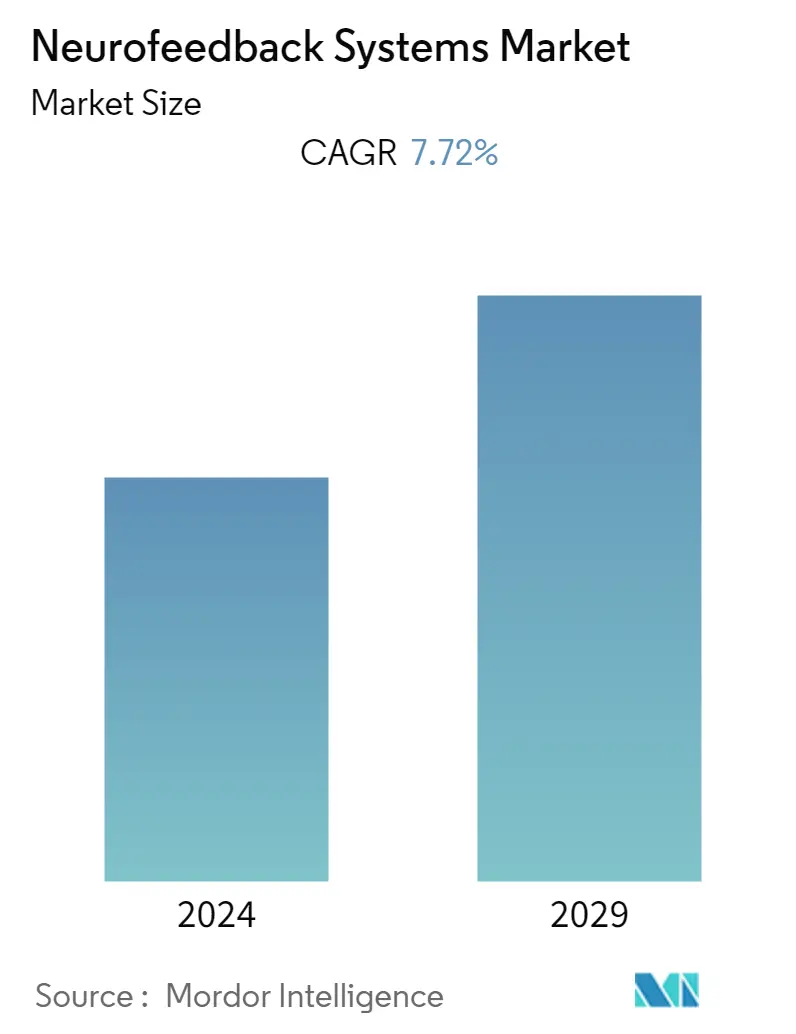
| Study Period | 2018 - 2028 |
| Market Size (2023) | USD 1.23 Billion |
| Market Size (2028) | USD 1.78 Billion |
| CAGR (2023 - 2028) | 7.72 % |
| Fastest Growing Market | Asia-Pacific |
| Largest Market | North America |
Major Players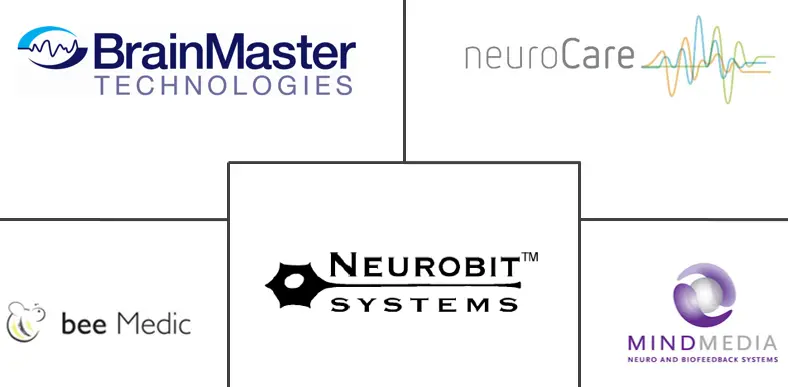
*Disclaimer: Major Players sorted in no particular order |
Need a report that reflects how COVID-19 has impacted this market and its growth?
Neurofeedback Systems Market Analysis
The Neurofeedback Systems Market size is expected to grow from USD 1.23 billion in 2023 to USD 1.78 billion by 2028, at a CAGR of 7.72% during the forecast period (2023-2028).
During the COVID-19 pandemic, the mental state of individuals was greatly affected, and consequently, many people suffered from different psychiatric and neuropsychiatric disorders. As per the study 'Global Prevalence and Burden of Depressive and Anxiety Disorders in 204 Countries and Territories in 2020 due to the COVID-19 Pandemic,' there were an estimated 75.2 million people dealing with anxiety disorders in 2020. The cases increased by 25.6% in 2020 compared to 2019. Therefore, the COVID-19 pandemic provided the opportunity for market players to develop innovative methods to address the global burden of the increasing number of anxiety disorders, thereby impacting the market's growth.
Neurofeedback refers to either positive or negative biofeedback produced from desirable or undesirable brain activities. In the past decade, the increasing incidences of neurogenerative diseases worldwide have been one of the major factors for the growth of the market. According to the World Health Organization (WHO), in 2021, more than 55 million people were living with dementia worldwide, and there are nearly 10 million new cases every year. Alzheimer's disease is the most common form of dementia and may contribute to 60-70% of the cases. In an article published by The Lancet journal in 2022, it was estimated that the number of people with dementia would increase from 57.4 million cases globally in 2019 to 152.8 million cases in 2050. Therefore, the increasing prevalence of such neurodegenerative disorders across the global population is expected to drive the market's growth in the forecast period.
Several studies have been conducted on neurofeedback therapy and its effectiveness in the treatment of several diseases related to brain diseases. Many brain dysfunctions such as anxiety disorder, epilepsy, pain, and others can be treated using the neurofeedback system. All the activities are recorded by an electroencephalogram (EEG), which is the primary device connected to neurofeedback systems. The steady technological advances and innovative product launches in this domain are also boosting the growth of the market studied. For instance, in May 2020, Naxon Labs launched Explorer, a neurofeedback system for professionals in the fields of engineering and information technology, neuroscience, and medicine. This system helps display real-time brain wave frequencies through any output device with Bluetooth connectivity. Therefore, due to the abovementioned factors, the market is expected to grow during the forecast period.
However, with advances in other technologies related to brain monitoring, these neurofeedback systems are costly and time-consuming, and also the efficacy of the treatment via advanced technologies is validated well across different geographies, which limits the usage of neurofeedback systems. Therefore, these factors are acting as some of the major restraints to the market studied.
Neurofeedback Systems Market Trends
This section covers the major market trends shaping the Neurofeedback Systems Market according to our research experts:
Treatment of ADHD Expected to be a Major Market Contributor Over the Forecast Period
Attention Deficit Hyperactivity Disorder (ADHD) is one of the most common neurodevelopmental disorders of childhood. It is usually first diagnosed in childhood and often lasts into adulthood. Patients suffering from ADHD, particularly children, may have trouble paying attention, controlling impulsive behaviors, or may be overly active.
The major factors fueling the segment’s growth are the increasing focus on research and development of neurofeedback therapies and devices and the growing burden of ADHD worldwide. For instance, as per a study published in February 2021, titled “The Prevalence of Adult Attention Deficit Hyperactivity Disorder: A Global Systematic Review and Meta-analysis,” the prevalence of persistent adult ADHD was 2.58%, and that of symptomatic adult ADHD was 6.76%, translating to 139.84 million and 366.33 million affected adults, respectively, in 2020 globally. Thus, such studies indicate that the demand for neurofeedback systems for the study and treatment of ADHD is increasing, thereby contributing to market growth.
Additionally, several studies reflect the efficacy of neurofeedback systems for ADHD that indicate the rising need for adoption of these systems for ADHD, which contributes to the market growth. For instance, as per an August 2021 published study titled, “A Randomized-controlled Neurofeedback Trial in Adult Attention Deficit Hyperactivity Disorder,” findings support the assumption of neurofeedback as a neurobiological treatment approach with non-specific as well as specific modes of action associated with regulation abilities.
Moreover, the increasing focus on research and development is leading to the development of effective neurofeedback systems, thereby contributing to market growth. For instance, as per an October 2021 update by the NIHR Maudsley Biomedical Research Centre 2022, a May 2020 published study titled “Neurofunctional and Behavioral Measures Associated with fMRI-Neurofeedback Learning in Adolescents with Attention Deficit/Hyperactivity Disorder” led to the Medical Research Council funding GBP 1.3 million for a larger trial with 100 children with ADHD, to compare fMRI-neurofeedback to a placebo that is not related to their own brain activity. The work also led to new collaborations locally and with the National Institute of Mental Health and Dresden University. The team has since secured funding (approximately GBP 2 million from NIHR, Action Medical Research) to trial other brain-based therapies in ADHD, including different types of non-invasive brain stimulation treatments such as transcranial direct current stimulation and stimulation of the trigeminal nerve, which is responsible for sensations in the face. Thus, the aforementioned factors are likely to drive the segment’s growth during the forecast period.
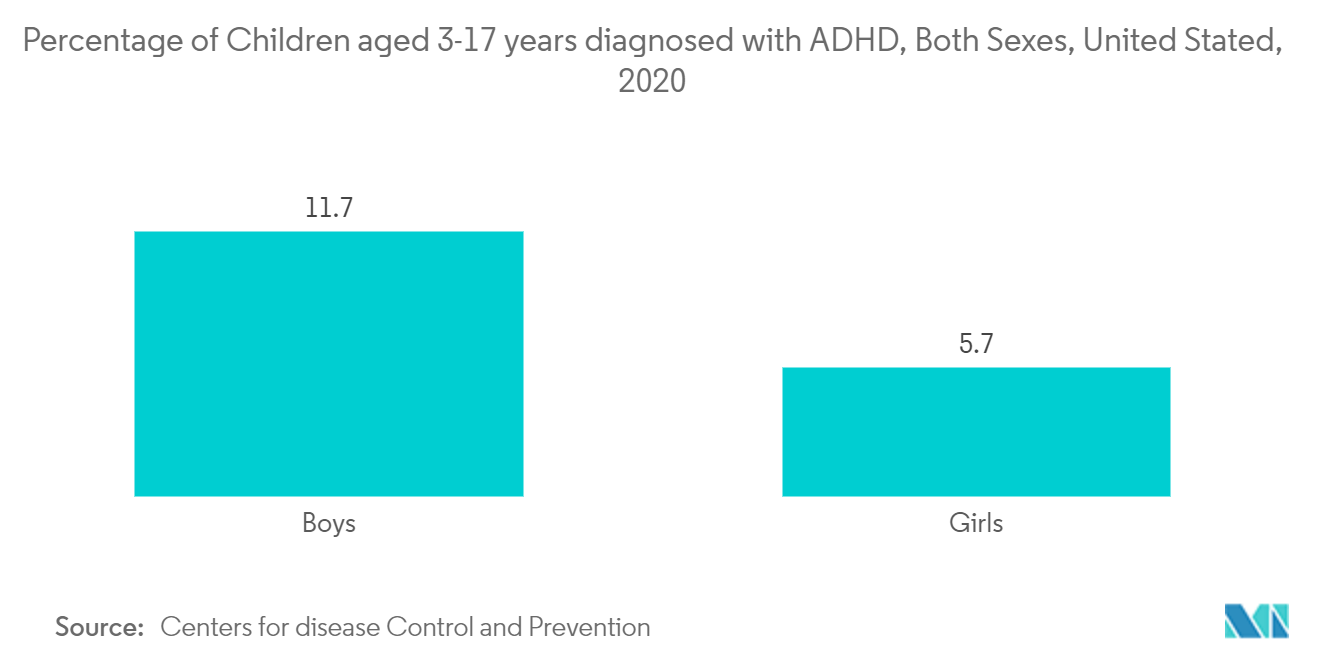
North America Expected to Hold a Significant Share in the Market with Similar Trends in the Forecast Period
With its advanced healthcare infrastructure and the presence of many medical device companies that are well-connected with the hospitals, North America primarily boosts the growth of this market. Since many companies opt for clinical advancement activities from the developed markets, mainly the United States, it also makes North America the major contributor to the growth of this market.
The rising prevalence of target diseases in this region is a major driving factor for the market’s growth. According to the American Academy of Sleep Medicine 2020, insomnia affects up to 20% of persons in the United States each year. Youngsters with poor sleeping patterns are more likely to develop behavioral insomnia, affecting 30% of children. Additionally, as per the Anxiety and Depression Disorders Association of America (ADAA), in 2020, anxiety disorders affect 40 million Americans aged 18 and above every year. Thus, the high rate of insomnia and anxiety disorders drives the necessity of neurofeedback systems in this region, thereby boosting the market’s growth.
The introduction of new items by various firms also aids the market segment’s growth. For example, in October 2019, Narbis made its proprietary Narbis smart glasses available, which combine neurofeedback principles and a NASA-developed algorithm to reduce distractibility and improve attention when reading, working on the computer, studying, or completing homework online. The availability of identical products both online and offline expands customer reach, driving the market growth. Also, the presence of several foundations, which act as support systems for many healthcare providers associated with the treatment of brain dysfunctions, fuels the neurofeedback systems market.
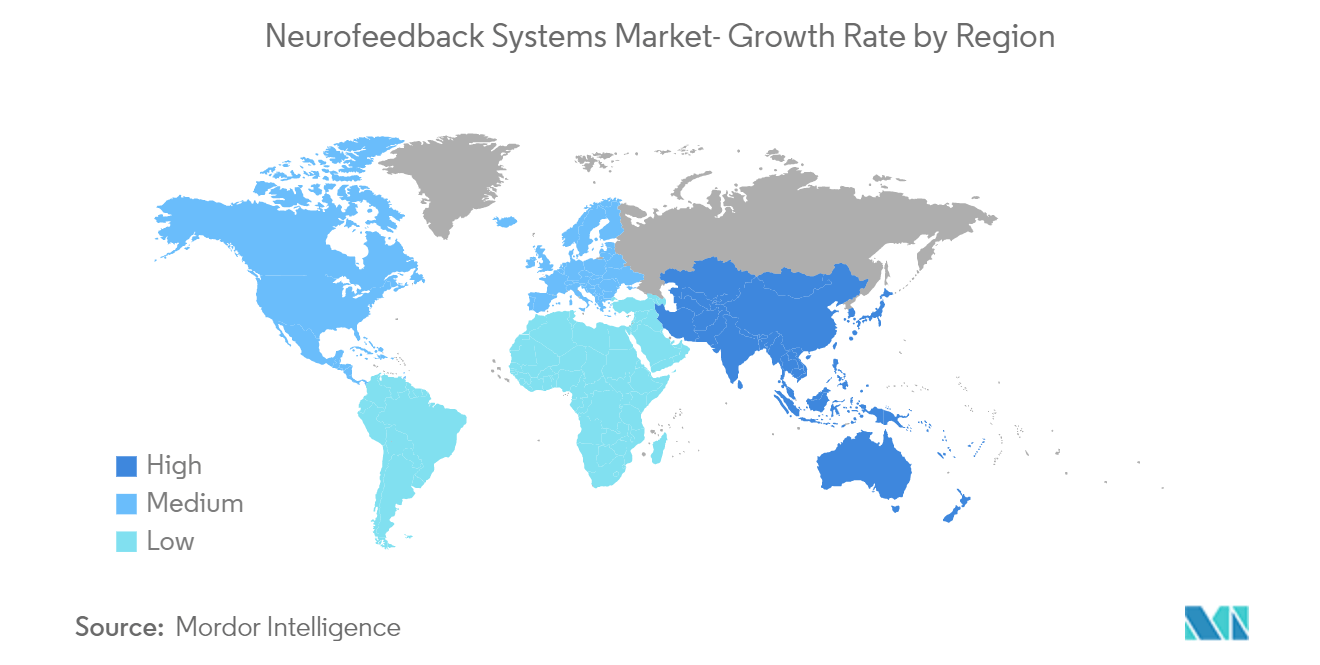
Neurofeedback Systems Industry Overview
With the growth in better diagnosis and treatment of brain diseases leading to greater demand for EEG devices, manufacturers are investing in neurofeedback systems that help in better processing of information obtained from EEG devices. Some of the major companies in this segment include Brainmaster Technologies Inc., Mind Media, NeuroCare Group GmbH, Neurobit Systems, BEE Medic, and others.
Neurofeedback Systems Market Leaders
Brainmaster Technologies, Inc
Mind Media
NeuroCare Group GmbH
Neurobit Systems
BEE Medic
*Disclaimer: Major Players sorted in no particular order
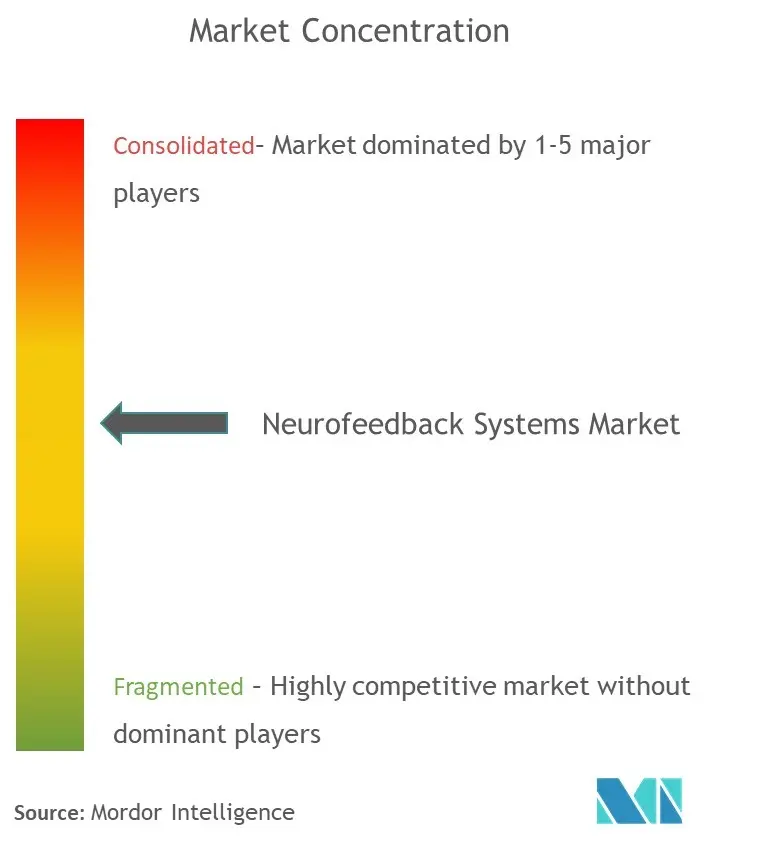
Neurofeedback Systems Market News
· In November 2021, Divergence NeuroTechnologies and OVID Clinics GmbH entered a collaboration for OVID to pilot a cloud-based clinical assessment and neurofeedback software system.
· In October 2021, Interaxon Inc. launched the second generation of its popular EEG meditation and sleep headband Muse S. This updated plush brain-sensing headband uses real-time neurofeedback to help learn the art of meditation for falling asleep.
Neurofeedback Systems Market Report - Table of Contents
1. INTRODUCTION
1.1 Study Assumptions and Market Definition
1.2 Scope of the Study
2. RESEARCH METHODOLOGY
3. EXECUTIVE SUMMARY
4. MARKET DYNAMICS
4.1 Market Overview
4.2 Market Drivers
4.2.1 Increasing Burden of Brain Dysfunctions
4.2.2 Increasing Technological Advances Toward Brain Monitoring
4.3 Market Restraints
4.3.1 High Cost and Time Consuming
4.4 Porter's Five Forces Analysis
4.4.1 Bargaining Power of Suppliers
4.4.2 Bargaining Power of Buyers/Consumers
4.4.3 Threat of New Entrants
4.4.4 Threat of Substitute Products
4.4.5 Intensity of Competitive Rivalry
5. MARKET SEGMENTATION
5.1 By Application
5.1.1 Attention Deficit Hyperactivity Disorder (ADHD)
5.1.2 Pain Management
5.1.3 Insomnia
5.1.4 Anxiety Disorder
5.1.5 Other Applications
5.2 Geography
5.2.1 North America
5.2.1.1 United States
5.2.1.2 Canada
5.2.1.3 Mexico
5.2.2 Europe
5.2.2.1 Germany
5.2.2.2 United Kingdom
5.2.2.3 France
5.2.2.4 Italy
5.2.2.5 Spain
5.2.2.6 Rest of Europe
5.2.3 Asia-Pacific
5.2.3.1 China
5.2.3.2 Japan
5.2.3.3 India
5.2.3.4 Australia
5.2.3.5 South Korea
5.2.3.6 Rest of Asia-Pacific
5.2.4 Middle-East and Africa
5.2.4.1 GCC
5.2.4.2 South Africa
5.2.4.3 Rest of Middle-East and Africa
5.2.5 South America
5.2.5.1 Brazil
5.2.5.2 Argentina
5.2.5.3 Rest of South America
6. COMPETITIVE LANDSCAPE
6.1 Company Profiles
6.1.1 Brainmaster Technologies Inc.
6.1.2 BEE Medic
6.1.3 Neurobit Systems
6.1.4 NeuroCare Group GmbH
6.1.5 Thought Technology Ltd
6.1.6 Mind Media BV
6.1.7 Wearable Sensing
6.1.8 Mitsar Co. Ltd
6.1.9 Myndlift
- *List Not Exhaustive
7. MARKET OPPORTUNITIES AND FUTURE TRENDS
Neurofeedback Systems Industry Segmentation
Neurofeedback systems are used by medical professionals to measure and train the human mind to understand their physiological processes in order to enhance the health and lifestyle of diseases patients. The market is segmented by application (ADHD, pain management, insomnia, anxiety disorder, and other applications) and geography (North America, Europe, Asia-Pacific, Middle-East and Africa, and South America). The report also covers the estimated market sizes and trends of 17 countries across major regions globally. The report offers values (in USD million) for the above segments.
| By Application | |
| Attention Deficit Hyperactivity Disorder (ADHD) | |
| Pain Management | |
| Insomnia | |
| Anxiety Disorder | |
| Other Applications |
| Geography | ||||||||
| ||||||||
| ||||||||
| ||||||||
| ||||||||
|
Neurofeedback Systems Market Research FAQs
How big is the Neurofeedback Systems Market?
The Neurofeedback Systems Market size is expected to reach USD 1,229.81 million in 2023 and grow at a CAGR of 7.72% to reach USD 1,783.69 million by 2028.
What is the current Neurofeedback Systems Market size?
In 2023, the Neurofeedback Systems Market size is expected to reach USD 1,229.81 million.
Who are the key players in Neurofeedback Systems Market?
Brainmaster Technologies, Inc, Mind Media, NeuroCare Group GmbH, Neurobit Systems and BEE Medic are the major companies operating in the Neurofeedback Systems Market.
Which is the fastest growing region in Neurofeedback Systems Market?
Asia-Pacific is estimated to grow at the highest CAGR over the forecast period (2023-2028).
Which region has the biggest share in Neurofeedback Systems Market?
In 2023, the North America accounts for the largest market share in the Neurofeedback Systems Market.
Neurofeedback Systems Industry Report
Statistics for the 2023 Neurofeedback Systems market share, size and revenue growth rate, created by Mordor Intelligence™ Industry Reports. Neurofeedback Systems analysis includes a market forecast outlook to 2028 and historical overview. Get a sample of this industry analysis as a free report PDF download.
